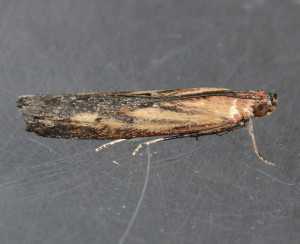More Attention Needed To Control Lesser Cornstalk Borers

Photo by Mark Dreiling
Crops Affected
The lesser cornstalk borer (Elasmopalpus lignosellus) may be a serious pest on Florida sweet corn. In addition to corn, it also attacks more than 60 other plant species and crops such as cabbage, beans, wheat, and sugarcane, as well as a variety of weeds.
Identification
The lesser cornstalk borer occurs widely in the western hemisphere. Despite its wide distribution, damage is limited principally to crops on the dry sandy soils of the coastal plain of the southeastern states from South Carolina to Texas.
The larvae cause damage when they tunnel within the stems of plants. Normally, damage from tunneling is restricted to the lower portion of the stem, and girdling may occur. Symptoms on corn plants include stunting, wilted or curled plants, and entrance holes and tunnels at the base of the plant indicating feeding activity of the larvae, which wriggle strongly when disturbed. Plant death is not uncommon, and infested areas of fields may reflect a poor stand. Sweet corn plants may not die and might produce bushy stunted suckers with no marketable ears.
The adult moth is fairly small and varies in coloration depending on climatic and regional conditions. The female moth is often charcoal-colored with wings held straight back along the body, while the male moth is tan-colored with charcoal wing strips. Adults are most active on warm, still nights.
During the early instars, larvae are yellowish green, with reddish pigmentation forming crosswise bands. As the larvae mature, whitish longitudinal stripes develop so that by the fifth instar they are pronounced. The mature larvae are bluish green, with distinct yellowish white stripes dorsally. Head capsules are dark in color.
Survival And Spread
After emerging from the soil and mating, the female moth deposits its eggs at the base of the host plant, with each female laying about 125 eggs. Within a week, the eggs hatch and the newly emerged caterpillars feed on the foliage. Later, they burrow into the stem, forming tubes at or just beneath the soil surface. The silk tunnels around their feeding sites protect them during the two to three weeks it takes for them to complete larval development. They pupate in the soil or tunnels, and after another two to three weeks, the adults emerge. There are several generations per year, and an overlap of generations occurs in late summer.
Management Methods
Pheromone traps have been used successfully to monitor adult populations, and adults can be flushed from fields by beating the vegetation.
Tillage and good weed control prior to planting might help destroy larvae that may be present in the soil.
Timing of control is important since borers cannot be controlled after entering the stem. Soil insecticides used for stalk borer control must be applied at or just after planting. Granular formulations applied in the seed furrow or in a band over the seed bed are most commonly used.
Consult UF/IFAS recommendations for currently labeled insecticides for lesser cornstalk borer control in Florida vegetables.










